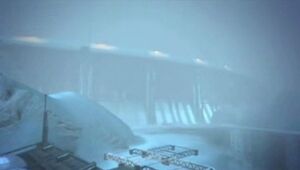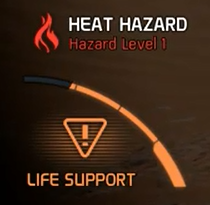Environmental hazards usually occur on planets with hostile environments.
Mass Effect[]
EVA Hazards[]
Some worlds are dangerous to explore on foot, either from extreme conditions, radiation, pressure or biological contamination. The dangers are ranked as Levels 1, 2, and 3 and are listed on the planet's description on the Galaxy Map. Upon exiting the Mako's environmentally sealed interior, a hazard timer will begin to fill, with the rate of fill being faster with a higher hazard level. When the hazard meter is full, the character will begin taking health damage until death occurs. The timer can be reset by entering the Mako or large structures; small portable cabins do not guard against a hazardous environment. If it is necessary to spend an extended period on foot some hazards can be negated entirely by wearing Devlon Industries's Armor; if any member of the squad is wearing such armor, it will negate the timer on environments with Level 1 environmental hazards and slow down the timer on Level 2 for the entire party.
Common hazards include:
- Heat
- Extreme cold
- Pressure
- Toxic agents (pollen, bacteria)
- Radiation
Legendary Edition: In Mass Effect Legendary Edition, lava is now rendered as a Level 8 generic hazard. The Mako no longer suffers instant destruction on encountering molten lava, but now takes rapid damage over time. Characters are still instantly killed. For whatever reason, the lava encountered on Nonuel still instantly destroys the Mako.
EVA Hazards are encountered in the following locations:
| Cluster | System | Planet | Hazard | Hazard Level |
|---|---|---|---|---|
| Attican Beta | Hercules | Eletania | Toxic | Level 1 |
| Gemini Sigma | Han | Mavigon | Cold | Level 2† |
| Argos Rho | Hydra | Metgos | Heat | Level 2 |
| Hades Gamma | Plutus | Nonuel | Heat | Level 1 |
| Horse Head Nebula | Pax | Noveria | Cold | Level 1 |
| Artemis Tau | Macedon | Sharjila | Pressure | Level 1 |
| Armstrong Nebula | Grissom | Solcrum | Heat | Level 1 |
| Artemis Tau | Knossos | Therum | n/a | Level 8†† |
| Horse Head Nebula | Strenuus | Xawin | Cold | Level 1 |
†Mavigon's hazard level is incorrectly listed in the planet description as Level 1.
††Mass Effect Legendary Edition only.
Interior Hazards[]
Environmental damage applies not only to EVAs, but interior hazards like falling boxes, or exploding power junctions which cause toxic damage if destroyed in close proximity. Another danger is from containment cells, often found in mercenary bases, mines or derelict starships:
- Fusion containment cells cause toxic damage.
- Ion containment cells release an electrical discharge that damages shields.
- Cryo containment cells release Bose-Einstein condensate that causes cold damage.
On all worlds, fires are ranked as Level 2 or 3 hazards, depending on the size of the fire, and ignore shields. Getting too close to one will destroy a character's health very quickly.
Mass Effect: Andromeda[]
Mass Effect: Andromeda returns to the hazard system found in Mass Effect. However, this time the ND1 Nomad vehicle will take damage from environmental hazards unlike the M35 Mako.
Overview[]
Planets and certain areas contain hazards that damage Pathfinder Ryder and the ND1 Nomad. (Any point past this, "Ryder" refers to both Pathfinder Ryder and the Nomad unless otherwise specified.)
- Hazard levels are 1, 2, 3, & 4 in Mass Effect: Andromeda.
- Any time that a hazard is encountered, Ryder automatically switches over to Life Support. A Life Support display in the lower left of the screen will list the Hazard Specific Icon, Hazard Type, Hazard Level, and the remaining Life Support that Ryder has available.
- SAM will provide audio commentary about entering, changing, or leaving hazard areas each time.
- Hazard levels are conspicuously displayed in the center of the screen each time that Ryder enters (interacts with) a hazardous area.
- When Ryder leaves a hazard area, a conspicuous display listing "SAFE CONDITION" will appear on screen.
- When Ryder changes hazard level (up or down but still a hazard), a conspicuous display will appear on screen.
- Forward Stations provide protection and will replenish Life Support for both Pathfinder Ryder and the Nomad.
- Ryder takes damage to Life Support any time that an environmental hazard is encountered.
- While Ryder is inside the Nomad, Life Support lasts much longer. A vehicle provides more protection. The exception to this rule is Level 4 hazards. Level 4 hazards will damage the Nomad just as quickly as they damage Pathfinder Ryder.
- When Ryder exits the Nomad, Ryder's Life Support takes over from where the Nomad's Life Support left off.
- When Ryder enters the Nomad, Life Support is recharged for Pathfinder Ryder. Note: The Life Support recharging process for Pathfinder Ryder is VERY slow in the Nomad compared to other recharging methods.
- As hazard level increases, the amount of time before Life Support is depleted decreases rapidly. Level 1 Heat hazard may take 15 minutes to fully deplete Life Support while Level 4 immediately depletes all Life Support and shields on contact with 1 additional second of contact killing Ryder. Walking into a lava pool is a Level 4 Heat Hazard.
- Depleted Life Support will replenish fairly quickly as long as Ryder stays in a SAFE CONDITION area.
- Pathfinder Ryder can extend suit Life Support with the consumable Backup Life Support.
- The Nomad can be upgraded with Advanced Life Support and Supplemental Life Support to give additional Life Support protection options.
- Once Life Support is depleted for Ryder, shields will be damaged until gone, and then health will be damaged until death.
Fires, lava, burning sulfur, Scourge tendrils, electric ferrofluid, lightning bolts, electric discharges, toxic ooze, as well as other hazards found during exploration and missions, tend to be high level hazards that quickly deplete Life Support. Don't assume that the cool looking animation is just a background element.
- Note: Scourge tendrils tend to be very sporadic for electrical damage. Most don't harm Ryder at all but those that do hit hard with an ELECTRICAL DISCHARGE Hazard Level 4 ELECTRICAL CURRENT 769,179 mA.
- Note: Electric ferrofluid is always a high level hazard and should be avoided at all costs. Occasionally electric ferrofluid will be an ELECTRICAL DISCHARGE Hazard Level 3 ELECTRICAL CURRENT 204,095 mA but most of the time is an ELECTRICAL DISCHARGE Hazard Level 4 ELECTRICAL CURRENT 769,179 mA.
- Note: The numerous burning wrecks one can find all over the Voeld op zone are purely ornamental. Their flames neither deal damage nor refill Ryder's Life Support bar. Players should keep this in mind while planning how to approach enemy forces at these locations, lest they run out of Life Support in the middle of nowhere.
- Note: Ryder is the only character in the game that needs to worry about environmental hazards. Their squadmates as well as all enemies are immune to all forms of environmental hazards.
Displayed Hazard Values[]
Displayed hazard values (as well as safe conditions) have slight variations/fluctuations. The on screen display may say Hazard Level 1 - TEMPERATURE 50.98°C in one location but if Ryder walks into a safe zone and enters another Hazard Level 1 area this new area may display TEMPERATURE 50.94°C. Just like the real world, there are minor normal fluctuations in the measurement of a variable. The only thing to take note of is that the Hazard encountered is a Level 1 hazard and that it causes slow damage over time to Life Support. Hazards don't magically change from one level to another over time but stay fixed for the locations in which they are encountered. Note: Actions that change the conditions of a planet such as activating a vault will change the hazard values.
The only exception to the displayed hazard values rule is for the Level 4 hazards. These numbers may be wildly different but will ALWAYS be serious trouble. Heat Hazard Level 4 for a burning fire - TEMPERATURE 124.56°C is just as deadly as molten lava - TEMPERATURE 1,231.97°C.
Another thing of note is that very few of the displayed values make scientific sense regarding their effects on Ryder. Temperatures between 30°C and 50°C above or below zero certainly are challenging to the human body, but even today some well-chosen basic clothing is sufficient to protect the wearer from the worst of their effects for hours, if not days on end. Similarly, the Level 1 and 2 Radiation Hazards show dosage values far too low to induce even the mildest symptoms of radiation poisoning in human physiology regardless of clothing, and common OSHA-compliant insulating clothing would neutralize the majority of electrical and toxic hazards as displayed. A trained fighter like Ryder who is also clad in sophisticated powered armor should not be bothered by most the displayed environmental hazards at all except for the rare Level 4 examples, much less killed by them after a maximum of 15 minutes of exposure.
Planets[]
Planets that Pathfinder Ryder can visit each have their own environmental hazards prior to the activation of the Remnant vault. Once the vault is activated, the Hazard Levels will be removed (or reduced).
| Planet | Hazard | Detailed Hazard |
Details | Vault Mission |
|---|---|---|---|---|
| Elaaden | Heat | Heat Levels | Any location not in permanent deep shade or indoors will cause constant damage to Life Support. | Taming a Desert |
| Eos | Radiation | Radiation Levels | Any location outside of specially shielded areas will cause constant damage to Life Support. | A Better Beginning |
| H-047c | Radiation | Radiation Levels | Unlike other planets, the radiation on H-047c is high enough that Pathfinder Ryder can't leave the Nomad. Any time that the Nomad is outside of the protection of a shielded area, the Nomad takes constant damage to Life Support. | N/A |
| Havarl | None | N/A | Havarl doesn't have an environmental hazard. | A Dying Planet |
| Kadara | Toxic | Toxic Levels | Unlike other planets, the damage to Life Support only occurs if Ryder enters a sulfur water pool. | Healing Kadara's Heart |
| Voeld | Cold | Cold Levels | Any location not heated or indoors will cause constant damage to Life Support. | Restoring a World |
Note: H-047c has no vault so the Hazard Level can't be reduced.
Note: Unlike other planets, Voeld only has a partial reduction in Hazard Level and not a complete removal of the Hazard Level like other planets.


